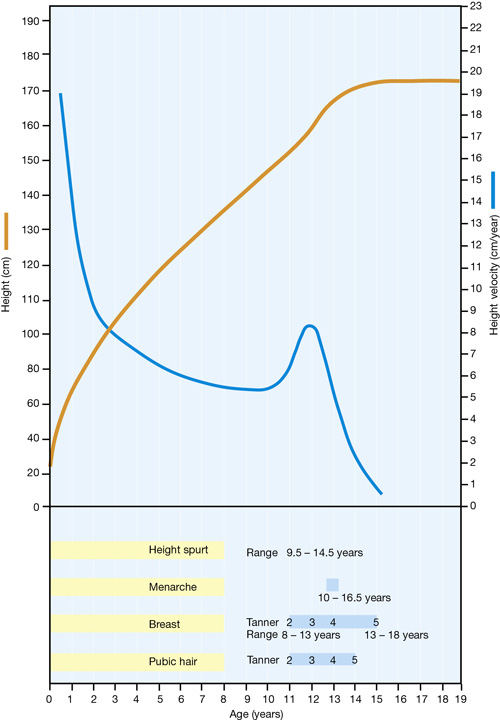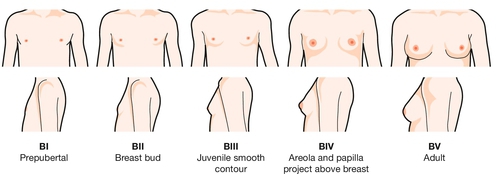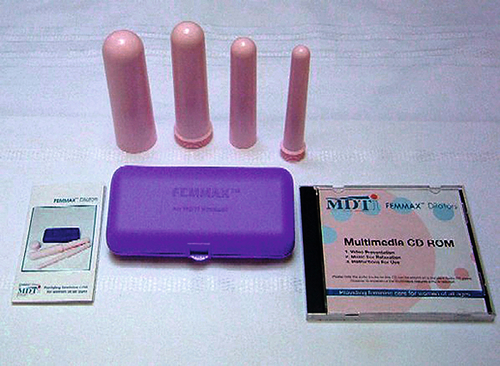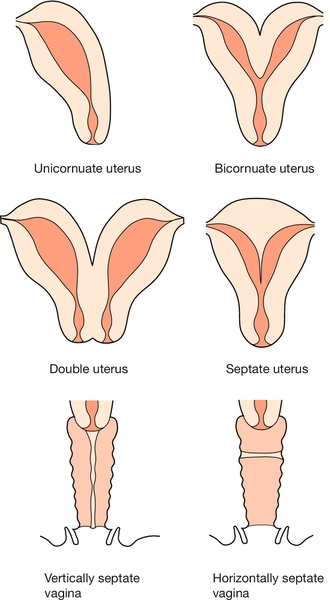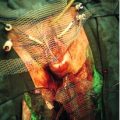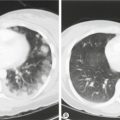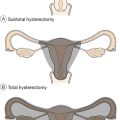5
Paediatric gynaecology
Introduction
Puberty should transform a girl into a fertile woman, and its social importance is so great that any deviation from normality may be the cause of considerable embarrassment and anxiety. This chapter describes normal puberty and outlines the management of both delayed puberty and precocious puberty. There is also a short discussion about sexual abuse.
Normal puberty
Puberty encompasses:
![]() an adolescent growth spurt
an adolescent growth spurt
![]() the acquisition of secondary sexual characteristics
the acquisition of secondary sexual characteristics
![]() the onset of menstruation (menarche)
the onset of menstruation (menarche)
![]() the establishment of ovulatory function.
the establishment of ovulatory function.
Endocrine changes
Puberty begins with the reactivation of the hypothalamo–pituitary–ovarian axis, which has lain dormant from the 3rd or 4th month of postnatal life. During childhood, the hypothalamus and pituitary are highly sensitive to suppression by low levels of gonadal steroids. With the onset of puberty, this extreme sensitivity is lost.
The first recognized endocrine event is the appearance of sleep-related, pulsatile release of gonadotrophins. As puberty progresses, these extend throughout the 24 h of the day. These gonadotrophins lead to production of ovarian oestrogen, which initiates the physical changes of puberty. Changes in the ovaries are evident at an early stage. In normal girls, before any physical signs of puberty are apparent, ultrasonography demonstrates a progressive increase in the size of ovarian follicles, such that after the age of  years a multicystic appearance of the ovaries (defined as more than six follicles > 4 mm in diameter, in each ovary) can often be demonstrated.
years a multicystic appearance of the ovaries (defined as more than six follicles > 4 mm in diameter, in each ovary) can often be demonstrated.
Signs of puberty
The external signs of puberty usually (but not always) occur in a specific order (Fig. 5.1). The onset of the adolescent growth spurt is an early feature of puberty in girls and this acceleration in growth is dependent on growth hormone as well as gonadal steroids.
Almost at the same time, the subareolar breast bud appears (thelarche). Breast development, which is primarily under the control of ovarian oestrogens, is described in five stages (Fig. 5.2). The appearance of the breast bud is followed shortly afterwards by pubic and axillary hair (pubarche), mainly under the influence of ovarian and adrenal androgens (Fig. 5.3). Menarche is a late feature in the course of puberty.
Age of menarche
Since the turn of the 20th century, the average age for the onset of puberty has become progressively younger. In 1900, the average age of the menarche was approximately 15.5 years, while currently, it is 12.8 years. This has been attributed to improvement in socioeconomic conditions, nutrition and general health. This trend appears to have slowed or ceased in Western Europe and the USA during the past 30 years, as might be expected once nutrition and child care had reached an optimum level.
Influence of body weight
It had previously been proposed that the menarche was closely related to the attainment of a critical body weight, which in the USA and Europe was approximately 48 kg. Further analysis suggested that the significant component of body weight was body fat, which during the adolescent growth spurt increases to about 22% of body weight. This converts a lean body weight-to-fat ratio of 5:1 at the initiation of the growth spurt to one of 3:1 at the menarche. Factors which delay the attainment of a critical body weight may delay the menarche. These include:
![]() malnutrition
malnutrition
![]() slow growth before and after birth
slow growth before and after birth
![]() twins, who have a later menarche than singletons of the same population
twins, who have a later menarche than singletons of the same population
![]() athletic training, as it results in an increased proportion of lean body mass at the expense of adipose tissue; for each year of premenarcheal training, the menarche is delayed by 5 months
athletic training, as it results in an increased proportion of lean body mass at the expense of adipose tissue; for each year of premenarcheal training, the menarche is delayed by 5 months
![]() eating disorders; anorexia nervosa in particular can cause both primary and secondary amenorrhoea and a halt in pubertal progress.
eating disorders; anorexia nervosa in particular can cause both primary and secondary amenorrhoea and a halt in pubertal progress.
![]() environmental factors may also play a role; urban communities tend to have an earlier menarche than rural communities, as do girls from social class I when compared with girls from social classes II and III.
environmental factors may also play a role; urban communities tend to have an earlier menarche than rural communities, as do girls from social class I when compared with girls from social classes II and III.
Progression through puberty
Some 95% of normal girls attain stage 2 breast development (the appearance of the subareolar breast bud) by the age of 13.2 years; 50% will complete all stages of puberty in 2–3 years, while 97% will do so in 5 years.
The bone age, which is an index of physiological maturation, correlates closely with the menarche. It can be measured by an X-ray of the hand. A total of 80% of girls begin to menstruate at a bone age of 13–14 years.
After the menarche, menstrual cycles tend to be irregular, as ovulation is initially infrequent. Most girls take several months or even as long as 2–3 years to establish a regular cycle.
Delayed puberty
Definition
Delayed puberty in girls may be defined as the absence of physical manifestations of puberty by the age of 13 years. Primary amenorrhoea is defined as no menstruation by the age of 14 years, accompanied by failure to develop secondary sexual characteristics. It is also defined as no menstruation by the age of 16 years in the presence of normal sexual development, and this is discussed further in Chapter 6. In some instances, a girl may enter puberty but the normal progression is not maintained. This is described as ‘arrested puberty’.
Causes of delayed puberty
These features of delayed puberty fall into three main categories (Table 5.1).
Constitutional delay
Constitutional delay – in other words the girl is normal but inherently late in entering puberty – is the commonest cause of delayed puberty. Although these individuals are usually of short stature, and have usually been shorter than their peers for years, their height is generally appropriate for their bone age. All stages of development are delayed. They may be considered to be physiologically immature, with a functional deficiency of gonadotrophin-releasing hormone for their chronological age, but not for their stage of physiological development. There is frequently a history of delayed menarche in their mothers.
In these patients, bone age shows a better correlation with the onset and progression of puberty than does chronological age. On attaining a bone age of 11–13 years, they can be expected to enter puberty.
Hypogonadotrophic hypogonadism
This arises from a defect of gonadotrophin-releasing hormone (GnRH) secretion, and consequently of follicle-stimulating hormone (FSH) and luteinizing hormone (LH). It may be associated with:
![]() conditions affecting body weight, such as chronic systemic disease, malnutrition or anorexia nervosa
conditions affecting body weight, such as chronic systemic disease, malnutrition or anorexia nervosa
![]() central nervous system tumours, which may lead to interference with GnRH synthesis or secretion, or with its stimulation of the pituitary gonadotrophs; the most common of these rare conditions is craniopharyngioma
central nervous system tumours, which may lead to interference with GnRH synthesis or secretion, or with its stimulation of the pituitary gonadotrophs; the most common of these rare conditions is craniopharyngioma
![]() Isolated gonadotrophin deficiency is very rare. Such patients are generally of appropriate height for chronological age, in contrast to patients with central nervous system tumours, who usually have associated growth hormone deficiency, and to those with constitutional delay, who are short for chronological age. The commonest form is Kallmann syndrome (see History box), in which anosmia arising from agenesis or hypoplasia of the olfactory bulbs is associated with GnRH deficiency.
Isolated gonadotrophin deficiency is very rare. Such patients are generally of appropriate height for chronological age, in contrast to patients with central nervous system tumours, who usually have associated growth hormone deficiency, and to those with constitutional delay, who are short for chronological age. The commonest form is Kallmann syndrome (see History box), in which anosmia arising from agenesis or hypoplasia of the olfactory bulbs is associated with GnRH deficiency.
Primary ovarian failure (primary ovarian insufficiency)
Although primary ovarian insufficiency may occur in isolation, it is most commonly associated with chromosomal anomalies, particularly Turner syndrome (see History box). Ovarian failure may also occur following chemotherapy or radiotherapy, as the result of germ cell damage.
Other causes
These include hyperprolactinaemia and hypothyroidism.
Investigation and management of delayed or arrested puberty
The scheme of investigation follows logically from the differential diagnosis discussed above:
1. plasma FSH, LH, oestradiol, prolactin and thyroid function tests
2. karyotype
3. X-ray for bone age
4. cranial CT or MRI scan.
Management after results
Constitutional delay
Often, reassurance and continued observation are sufficient. It is important to reassure the parents as well as the girl herself. Where psychological problems arise as a result of comparison with her peers, treatment may be indicated. This may take the form of 3 months’ therapy with low-dose oestradiol, 2 μg daily. If necessary, this can be repeated.
Hypogonadotrophic hypogonadism
In those with low weight, restoration of weight usually results in spontaneous onset of puberty. Those with central nervous system tumours require appropriate neurosurgical treatment.
Where the defect lies at the hypothalamic level, for example with Kallmann syndrome, pulsatile administration of GnRH via an infusion pump results in progress through all stages of puberty in the course of 12 months. It is, however, a very demanding form of treatment and in most cases, replacement therapy with oestradiol is usually employed for physical maturation. Pulsatile GnRH treatment, however, is necessary if ovulation induction is required.
Primary ovarian failure
Girls with pure Turner syndrome will usually be infertile, although successful pregnancies can be achieved with ovum donation. Girls with ovarian insufficiency are also usually infertile although spontaneous ovulation is thought to occur in 5% of this group. They will require hormone replacement therapy throughout their lives until the age of 50. The first stage in treatment is to ensure normal progress through puberty, and this is achieved by oestrogen replacement therapy. It is commenced at a low dose (2 μg oestradiol daily) until breast development is adequate. It is important not to begin with higher doses, as this may result in poor breast development. Subsequently, higher doses of 10–20 μg daily may be introduced and a progestogen added to avoid unopposed oestrogen stimulation of the endometrium. Commonly, ongoing oestrogen replacement is with the combined oral contraceptive pill, although hormone replacement therapy can also be used.
Precocious puberty
The appearance of signs of sexual maturation prior to the age of 8 years in girls, constitutes precocious puberty. Central or gonadotrophic-dependent precocious puberty (GDPP) occurs when there is a pituitary or hypothalamic cause and peripheral or gonadotrophin-independent puberty occurs when puberty is induced by sex steroids from other courses such as a hormone secreting tumour. Often the normal sequence of pubertal development occurs at an early age. The growth spurt is a striking feature, but frequently it is the occurrence of menstruation which brings the girl to medical attention. Caution should be exercised in accepting blood loss as menstrual in origin before excluding a local lesion, such as a foreign body or even neoplasia of the vagina or cervix.
Children with precocious puberty should be under the care of a paediatric endocrinologist.
Causes of precocious puberty
Gonadotrophic-dependent precocious puberty (GDPP)
In 90% of girls with GDPP, no cause is found. In the remaining 10%, causes are intracranial and include encephalitis, meningitis, cranial radiation, hydrocephaly and space-occupying neoplasms such as optic nerve gliomas. Sexual abuse has been reported as a precipitating cause.
Gonadotrophic-independent precocious puberty (GIPP)
Causes of GIPP include feminizing tumours of the ovary or adrenal, which may give rise to vaginal bleeding without signs of pubertal development. Other causes include hypothyroidism, and the very rare McCune–Albright syndrome (see History box), in which cystic cavities develop in the long bones (polyostotic fibrous dysplasia) and café-au-lait skin pigmentation is evident. Other rare causes include ingestion of exogenous oestrogens.
Investigation and management of precocious puberty
1. Plasma FSH, LH, oestradiol and thyroid function tests
2. X-ray of the hand to determine bone age which may be advanced
3. Ultrasound scan of the abdomen and pelvis
4. Radiological skeletal survey of the long bones. Changes in the McCune–Albright syndrome may be restricted to one side of the body
5. Cranial CT or MRI scan.
Ultrasound examination by an experienced sonographer has become the mainstay of diagnosis. In the constitutional and cerebral forms, the ovaries will show the multicystic appearance previously described in normal puberty. It will also distinguish between a follicular cyst, which may be expected to subside spontaneously, and a predominantly solid oestrogen-secreting granulosa/theca cell tumour of the ovary, which will require surgical removal.
Treatment
With precocious puberty the aims of treatment are:
1. to prevent the progression of puberty and in particular to suppress menstruation
2. to maximize growth potential and psychosocial well-being.
Not all children need treatment, as symptoms may only be slowly progressive. Treatment prevents progression but does not usually reverse changes that have already happened. If an underlying aetiology is found, this should of course be treated.
The introduction of GnRH agonists, which suppress gonadotrophin secretion, has revolutionized the treatment of constitutional and cerebral precocious puberty. Preparations are available, which may be used intranasally or as a depot injection, and treatment can be continued for 2–3 years without significant side-effects. Treatment is stopped when an acceptable age for puberty is reached.
Abnormal genital tract development
Vagina
There may be horizontal septae, vertical septae or the vagina may be absent.
Horizontal septae
This can lead to menstrual obstruction. The presentation is with amenorrhoea with cyclical pain. An ultrasound will reveal a haemotocolpos where the vagina is filled with blood. If the obstruction is caused simply by an imperforate hymen, then a blue bulge is seen at the introitus due to blood behind the hymen. If this is the case, a minor surgical procedure to excise the hymen is all that is indicated to allow normal menstruation. If the lower vagina looks normal, this means the septum is higher in the vagina. This means the situation is potentially more serious and should be referred to a specialist surgeon. If the septum is in the low- or mid-portion of the vagina, total excision and resuturing is necessary. If the septum is high, a combined abdominal and vaginal approach may be required. Pregnancy rates are excellent with low septae but only around 25% for those higher in the vagina.
Vertical septae
These may be associated with abnormal uterine development. Although presentation may be with dyspareunia, infertility or occasionally in advanced labour, the septum is often asymptomatic. It can be surgically removed.
Vaginal agenesis
This is associated with an absent, or only a rudimentary, uterus and is known as the Rokitansky syndrome. Presentation is at puberty with amenorrhoea in the presence of normal secondary sexual characteristics. An ultrasound will be unable to identify the presence of a uterus. If the uterus is non-functioning, it is possible to create a vagina with regular use of vaginal dilators (Fig. 5.4) or by one of a variety of surgical techniques. Surrogacy is an option for childbearing.
Uterus
Abnormal uterine shapes (Fig. 5.5) are usually asymptomatic but may present with primary infertility, recurrent pregnancy loss or menstrual dysfunction (oligomenorrhoea, dysmenorrhoea or menorrhagia). In pregnancy, there may be miscarriage, pre-term labour or abnormal fetal lie.
Unicornuate uterus
With this, there is a higher miscarriage rate and risk of pre-term labour.
Bicornuate uterus
This may carry a pregnancy to an adequately advanced gestation, and the chance of this probably increases with successive pregnancies. Although surgical correction was undertaken in the past, this is no longer done, as the benefits for pregnancy are unproven. A bicornuate uterus may be asymmetrical with one side hypoplastic. Pregnancy in the hypoplastic horn carries a risk of rupture.
Septate uterus
If it is appropriate to remove the septum, a hysteroscopic approach is probably the most appropriate.
Sexual abuse
Sexual abuse is the sexual molestation of children by adults or older children. The aim is sexual gratification of the perpetrator. The activity is usually secretive and coercion in the form of violence, bribery and emotional threats ensure that the child cannot refuse. Sexual abuse can include non-contact activities (such as involving a child in watching pornography), as well as physical sexual contact. The abuser is most commonly male and often well known to the child and family.
Child sexual abuse may present to the medical services acutely, following injury or allegation or may be suggested by precociousness and other behavioural disorders. Symptoms and signs are age-related and can be highly variable as children develop a wide variety of complex coping mechanisms. There are numerous pitfalls to the clinical assessment and a depth of experience is required if the results of an examination are to stand up in court. Diagnosis should rarely be made on physical signs alone as more than half of sexually abused children have no abnormalities on examination. False allegations are rare and so disclosure by the child should be taken very seriously.
Where there is a high suspicion of abuse, early involvement of a senior experienced paediatrician is essential in this highly emotive area where incorrect interpretation of the signs may have major consequences. The use of a colposcope is important and photographic records are extremely useful. The history should be carefully taken and documented, and the social work team involved if appropriate. Forensic specimens (which may include swabs for DNA analysis) can be taken up to 7 days after the event and should be taken with a ‘secure chain of evidence’ in case they are required for a later legal action. The presence of signs depends on the type of abuse – whether oral, anal or vaginal – and the length of time since the most recent episode of abuse. Particular attention should be paid to bleeding, bruising or any other area of injury, particularly lacerations at the posterior fourchette and perineal abrasions.
A normal hymen has a number of different shapes (annular, crescentic, fimbriated, septate, sleeve or funnel-shaped) and these should not be confused with tears (Fig. 5.6A,B). Notches and clefts can be highly suggestive of penetrating injury, but may be normal if associated with an intravaginal ridge above them (Fig. 5.6C); they are very rare in the posterior segment in non-abused girls. ‘Straddle injuries’, caused by falling astride an object such as a fence, very rarely affect the hymen and there is much more likely to be bruising anterior to the vagina or laterally (e.g. labia majora). It is also rare for tampon use to cause hymenal injury (although it may increase the diameter slightly), and there are no reported cases of congenital absence of the hymen. It is important to remember that a normal pre-pubertal hymen does not exclude abuse.
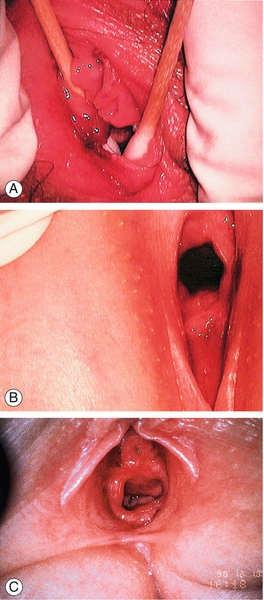
Fig. 5.6It is essential to differentiate normal hymenal views from those that are pathological.
(A) Acute tearing. (B) Partial-thickness tear at the posterior margin. (C) Concavities in the hymen. The correct differentiation of a tear from the normal appearance requires a suitably experienced opinion.
Paediatric vaginal discharge
Vaginal discharge is the commonest reason for referral of a prepubertal girl to a gynaecologist. Nonspecific bacterial vulvovaginitis is the most frequent cause. Vaginal cultures are often nonspecific but organisms such as group A beta-haemolytic streptococci and Haemophilus influenzae are sometimes isolated and should be treated with appropriate antibiotics.
Symptoms include discharge, soreness and itching and these can be chronic and distressing. Contributory aetiological factors include the hypo-oestrogenic state of the prepubertal vagina and hygiene. Rarer causes, such as a foreign body or tumour must be considered and excluded if symptoms are persistent. Sexual abuse should always be considered but is not the cause in the majority of cases. Threadworms can lead to generalized genital irritation and empirical treatment could be tried. Vulval hygiene – including avoidance of soaps in the genital area and the use of appropriate emollients – is the cornerstone of successful management.
Vaginal bleeding in the pre-pubertal girl always needs specialist referral and may require examination of the vagina, which is usually done under a general anaesthetic.

